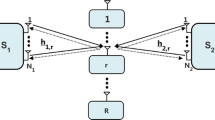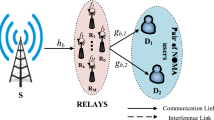Abstract
Performance of cooperative relay schemes employing infrastructure based fixed relays having multiple antennas, has been investigated. Closed form expressions of outage probability, bit error rate and throughput for such system have been derived for Nakagami-m fading channels, with integer values of m. Here, relay and destination may perform either maximum ratio combining or selection combining of the signals. Comparative performance analysis of all four possible combinations has been analyzed for various relay locations, different number of antennas on the relay, various transmission rate and different fading conditions.
Similar content being viewed by others
References
Nosratinia A., Hunter T. E., Hedayat A. (2004) Cooperative communication in wireless networks. IEEE Communications Magazine 42(10): 74–80
Laneman J. N., Tse D. N. C., Wornell G. W. (2004) Cooperative diversity in wireless networks: Efficient protocols and outage behavior. IEEE Transactions on Information Theory 50(12): 3062–3080
Beaulieu N. C., Hu J. (2006) A closed-form expression for the outage probability of decode-and-forward relaying in dissimilar rayleigh fading channels. IEEE Communications Letters 10(12): 813–815
Beres E., Adve R. (2007) Outage probability of selection cooperation in the low to medium SNR regime. IEEE Communications Letters 11(7): 589–597
Laneman J. N, Wornell G. W. (2003) Distributed space-time-coded protocols for exploiting cooperative diversity in wireless networks. IEEE Transactions on Information Theory 49(10): 2415–2425
Adinoyi A., Yanikomeroglu H. (2007) Cooperative relaying in multi-antenna fixed relay networks. IEEE Transactions on Wireless Communications 6(2): 533–544
Lee Y., Chen Y. N., Sou S. I. (2011) Error-rate performance of uplink cooperative communications with decode-and-forward protocol. IET Communications 5(11): 1484–1490
Katiyar H., Bhattacharjee R. (2010) Performance of MRC combining multi-antenna cooperative relay network. AEU-International Journal of Electronics and Communications 64(10): 988–991
Katiyar H., Bhattacharjee R. (2009) Outage performance of two-hop multi-antenna co-operative relaying in Rayleigh fading channel. IET Electronics Letters 45(17): 881–883
Katiyar, H., & Bhattacharjee, R. (2009). Average error rate of multi-antenna decode and forward cooperative relay network. In Proceedings of IEEE INDICON, India: DAIICT Ahmedabad.
Katiyar H., Bhattacharjee R. (2009) Performance of two-hop regenerative relay network under correlated Nakagami-m fading at multi-antenna relay. IEEE Communications Letters 13(11): 820–822
Katiyar, H., & Bhattacharjee, R. (2009). BER performance of regenerative multi-antenna cooperative relay network in Rayleigh fading channel. In Proceedings of UKIWCWS 2009, India: IIT Delhi, December 11–12.
Katiyar H., Bhattacharjee R. (2011) Average capacity and SNR analysis of multi-antenna regenerative cooperative relay in Rayleigh fading channel. IET Communications 5: 1971–1977
Katiyar H., Bhattacharjee R. (2011) Outage performance of multi-antenna relay cooperation in the absence of direct link. IEEE Communications Letters 15(4): 398–400
Thang, L. T., Tuyent, L. P., & Bao, V. N. Q. (2012). Outage performance of multi-antenna cooperative incremental relaying systems in the absence of direct link. In ICACT2012, February 2012.
Simon M.K., Alouini M.-S. (2005) Digital communication over fading channels. 2nd edn. Wiley, London
Adinoyi, A., & Yanikomeroglu, H. (2006). On the performance of cooperative wireless fixed relays in asymmetric channels. In Proceedings of IEEE Global Telecommunications Conference (pp. 1–5), December 2006.
Yang H.-C., Alouini M. S. (2005) MRC and GSC diversity combining with an output threshold. IEEE Transactions on Vehicular Technology 54(3): 1081–1090
Gradshteyn I. S., Ryzhik I. M. (2007) Table of integrals, series and products 7th revised edn. Academic Press Inc, New York
Eng T., Milstein L. B. (1995) Coherent DS-CDMA performance in Nakagami multipath fading. IEEE Transactions on Communications. 43(234): 1134–1143
Agustin A., Vidal J. (2008) Amplify-and-forward cooperation under interference-limited spatial reuse of the relay slot. IEEE Transactions on Wireless Communications 7(5): 1952–1962
Author information
Authors and Affiliations
Corresponding author
Rights and permissions
About this article
Cite this article
Katiyar, H. Comparative Performance Analysis of Multi-Antenna Regenerative Cooperative Relay in Nakagami-m Fading Channel. Wireless Pers Commun 71, 365–381 (2013). https://doi.org/10.1007/s11277-012-0819-8
Published:
Issue Date:
DOI: https://doi.org/10.1007/s11277-012-0819-8




